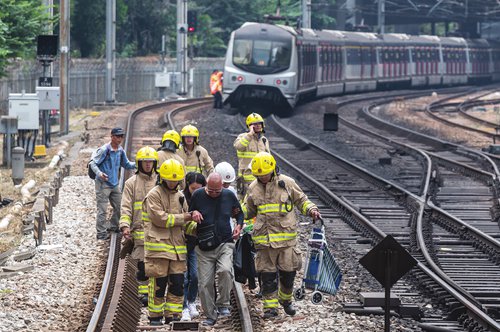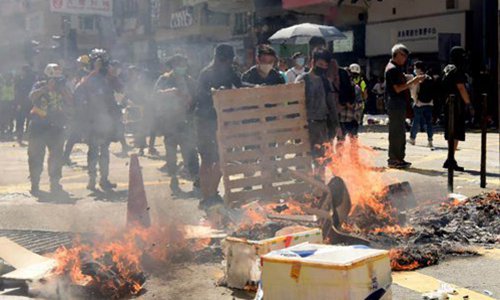HOME >> CHINA
Violent riots in HK show ‘final madness’
By Yang Sheng in Beijing and Zhao Yu in Hong Kong Source:Global Times Published: 2019/11/12 23:08:40 Last Updated: 2019/11/13 9:32:20

A man is escorted by firemen on train tracks at Sha Tin MTR station after rioters disrupted train services in Hong Kong on Tuesday. Hong Kong has again descended into chaos and violence since Monday after rioters blocked roads, set fires on streets and vandalized MTR trains, which greatly inconvenienced ordinary people. Photo: AFP
Endless "black-clad violence" continued to damage public order and security of Hong Kong, and observers from both the Chinese mainland and Hong Kong said on Tuesday that the rioters showed signs of a "final madness" as the number of participants have dropped and the riots are getting more and more extreme and losing support.
Some mainstream Western media's double standard and biased reports on the Hong Kong riots received anger and criticism, with experts noting that these media are not reporting based on facts and neutrality but on political needs, so they will put their focus on so-called police brutality rather than actual violent activities done by radical protesters.
Since 7am Tuesday morning, some radical protesters have been gathering at a footbridge leading to the student residence of City University of Hong Kong, Kowloon Tong, throwing bricks and other hard objects.
Some of them set up barricades and blocked the intersection of Cornwall Street and Tat Chee Avenue with bricks, wooden boards and iron railings.
They also threw hard objects at the rail line linking Fo Tan and Hung Hom, forcing passengers to get off the train and walk along the rails.
"This is the first time I have used an escape ladder of an MTR train, and I never dreamed that I would walk like this along the rails, which is absurd," a Fo Tan resident stuck in Sha Tin told the Global Times.
"Enough is enough. Will these black-clad rioters continue to destroy the city until they ruin everything?" other residents complained.
Hong Kong Police Force Senior Superintendent Kong Wing-cheung said at a press briefing on Tuesday that a bicycle thrown by rioters crashed with a train at Sha Tin station and the bicycle was stuck on the wheels of the train. "This kind of activity could bring serious casualties to people," Kong said.
At major roads near Hong Kong Polytechnic University, rioters continued their rampage on Tuesday morning, throwing hard objects, including glass, metal batons and road barricades from a footbridge, which almost hit passing cars. The Global Times reporters' taxi was almost hit by a metal baton thrown from above.
The campus has become a major battleground for student protesters.
At around 10:30 am, a group entered the storeroom at Chinese University of Hong Kong without permission, according to a statement issued by the school. They removed a number of bows, arrows and javelins, equipment normally used for athletic training purposes. And since the arrowheads are metallic, inappropriate use of these items may pose a serious danger to others, the school warned.
Rioters swarmed into the Chinese University of Hong Kong, which is among the world's 100 top tertiary institutions, into a "warzone" on Tuesday night as they continuously threw Molotov cocktails and set fires at the campus.

Black-clad rioters set fire on a street in Sai Wan Ho in Hong Kong on Monday. Photo: Xinhua
Totally biased
Even if the riots have angered and scared people, and seriously threatened public security, some Western mainstream media continued to focus on their criticism of the police.
No foreign journalist asked questions about the man whom rioters set fire to on Monday in Ma On Shan. A CNN journalist constantly asked the police whether the police have lost control, as an officer shot a rioter on Monday morning. Only a reporter from the mainland asked a question about the burned victim.
Yang Guang, spokesperson of the Hong Kong and Macao Affairs Office of the State Council, on Tuesday condemned the setting of the 57-year-old resident on fire.
"We firmly support the HKSAR government, the police and judicial organs to conduct more powerful, decisive and effective actions to punish illegal criminal activities, to stop violence and chaos and restore public order," he said.
Kong, the Hong Kong Police Force Senior Superintendent said, "In the past, when we drew our gun to warn rioters in emergencies, rioters would flee, but now, rioters would continue their attacks. Some people even teach rioters on social networks how to snatch guns from the police. This is extremely dangerous."
Instead of focusing on the illegal behavior of rioters, including setting fire to a train station, attacking innocent citizens, throwing Molotov cocktails at a school bus, and setting a middle-aged man on fire, foreign journalists have focused on only one question: Why did the police fire a live round?
On the video showing a police officer shooting the rioter on Monday, the Guardian cut off the part when the rioter used his hand to try to snatch the gun from the police.
Li Xiaobing, an expert on Hong Kong, Macao and Taiwan studies at Nankai University in Tianjin, told the Global Times that when reporting on Hong Kong, some Western and Hong Kong media outlets do not base their stories on facts and are not neutral, because this is not their purpose.
They are fighting a propaganda war against China's sovereignty in Hong Kong, and will unconditionally accuse the government and the police, and try their best to ignore the violence done by protesters, Li said.
"They are very experienced and professional in inciting a color revolution," he noted. "Remember what happened before the civil war in Ukraine and the 'Arab Spring?' They are doing exactly the same thing in Hong Kong."
'Final madness'
Experts said the current situation show signs of "final madness." The number of protesters will continue to dwindle but will get more violent.
Lau Siu-kai, vice-president of the Chinese Association of Hong Kong and Macao Studies, said that at this stage, the rioters will lose the support of society, and even residents who previously showed sympathy for them would no longer support them.
"So the police and the government should make no mistake and continue enforcing the law. The HKSAR government and Hong Kong police haven't used all measures to stop violence yet, so it is unnecessary to ask the central government to get involved," said Lau, who is also former head of the Hong Kong government's think tank, the Central Policy Unit.
"The central government has already started helping the HKSAR government stop the violence. For instance, it has placed diplomatic pressure on foreign forces who incite riots in Hong Kong, and also supplied equipment to the Hong Kong police," Lau said.
Li said that the government and groups which want to see stability should make efforts to reverse public opinion and condemn extreme political forces.
Newspaper headline: ‘Final madness’of HK riots
Posted in: HK/MACAO/TAIWAN